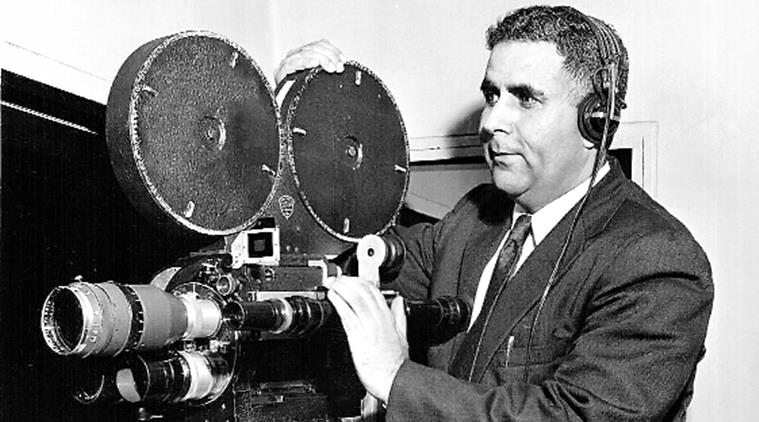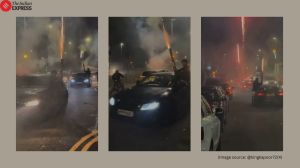A Fading Funeral
The legacy of an unknown Indian photographer who helped capture the last moments of the Mahatma.
 Man with a movie camera: Ved Parkash short newsreel helped capture Mahatma Gandhi’s funeral. (Source: Ved Films)
Man with a movie camera: Ved Parkash short newsreel helped capture Mahatma Gandhi’s funeral. (Source: Ved Films)
On January 30, 1948, at about six in the evening, screenings in cinema halls across Delhi were abruptly stopped to declare the news of Mahatma Gandhi’s assassination. As people reeled in shock and grief, a few men were faced with a task that was both an opportunity and a daunting challenge — to capture this big story on film.
Newsreels (short films featuring topical news items, usually on a single reel) had already been around in India for some time by then. But Gandhi’s assassination was, as one John Turner of Gaumount British News wrote in his biography, “a world story”. However, though Turner and other foreign journalists were better positioned to send this story out to the world, it was actually an Indian news cameraman, Ved Parkash, whose resourcefulness saved the day. His footage went into the making of Gandhi’s Funeral — a short film of no more than three minutes, that contains rare funeral footage of the Mahatma.
For years, even Parkash’s son had no idea about the historically significant film, which is now available to watch for free through the archive of British Pathe. “It was 2007. I was sitting on the computer when I suddenly decided to look up my father’s name. After a few hours of surfing on the internet, I stumbled upon chapter 7 (INDIA) of the book Filming History, The Memoirs of John Turner, Newsreel Cameraman,” says Rajiv, who runs a studio called Ved Films in Janpath, Delhi.
Turner had been especially roped in by Louis Mountbatten to cover his tenure in India. While there were four other newsreel companies operating in the country at the time (Pathe News, British Movietone, British Paramount New and Gamount British News, for which Turner worked), the only cameraman who had something akin to regular work as a stringer was Parkash. But Rajiv’s most crucial discovery was yet to be made. That happened in 2008 when he subsequently decided to open the many chests left behind by his father in the basement of their South Extension home in Delhi, and study the documents contained within. The fact that Gandhi’s Funeral was also nominated in the Special Film category at the 2nd BAFTA (British Academy for Film and Television Academy) awards, possibly the only news coverage film in history to be nominated, was something he discovered only then. “I had something so crucial and historically significant sitting in my basement.” Rajiv says.
Parkash, born in 1917 in Bhera Maini, Pakistan, became a stringer for British Paramount News in 1946. He covered Mountbatten’s time in India, the transition of power from the British to post-Independence India, the invasion in Kashmir, the Beatles’ visit to India and other important events. What makes Gandhi’s Funeral so special is that it happened mostly due to Parkash’s improvisations. Turner writes in his biography, that both he and Parkash did not even have the requisite amount of 35mm film required to shoot the ceremony on short notice. But, Turner says, “My only hope then was that I could work out something with Parkash. And thank goodness for that resourceful man.” Parkash, using all his local contacts, arranged for 3,000 ft of leftover reel overnight.
The letters that Parkash wrote in 1948 to his London editor, Len Green, gives an idea of the challenges that he personally had to overcome in the run-up to the filming. In a letter dated 18 January, Parkash writes that his house in Delhi was burgled and he was robbed of most of his equipment.
Unfortunately, little remains to substantiate in a foolproof manner, how Parkash went about shooting this particular film. In fact, details about his 30-odd years of work as a news cameraman within India, is even worse. The only personal account relating to the day of Gandhi’s funeral was recorded and preserved by Turner.
For Gandhi’s Funeral, BAFTA credits both Turner and Parkash, but British Paramount News’ own journal, Paramount International News (the clipping of which was Rajiv’s eureka moment), credits only Parkash. But, perhaps, most intriguing is how Turner, throughout his life, never mentioned the nomination to anyone. “It was quite shocking and intriguing to me that John Turner’s biography did not mention any such thing related to Gandhi’s Funeral, which he too was filming for Gaumount News,” Rajiv says. When contacted, the editor of Turner’s biography, Luke Mckernan, says, “It’s not something I ever heard John mention, and I can’t think of any reason why he would not want to mention it.”
Turner’s biography and the handful of documents that have survived in Rajiv’s archive, show that both Turner and Parkash shot the film. While Turner had the privilege of recording his experiences — in books and journals — Parkash, who was just trying to eke out a living, had no such luxury. He also died early, at the age of 57, in 1975. “I was 17 when dad passed away. I never really got the opportunity to discuss the film with him, even though people in his circle and journalists like him knew,” Rajiv says.
After 2007, Rajiv brought Parkash’s letters, documents, his 10 vintage cameras, and thousands of feet of spoiled footage out of the basement. He has since been working on a documentary about his father using his own finances. “There was no demand of him (as a father and a professional) that dad did not make a reality. I think I can only pay homage to his will with this film,” he says.
Manik Sharma is a Delhi-based freelance writer.





- 01
- 02
- 03
- 04
- 05


























